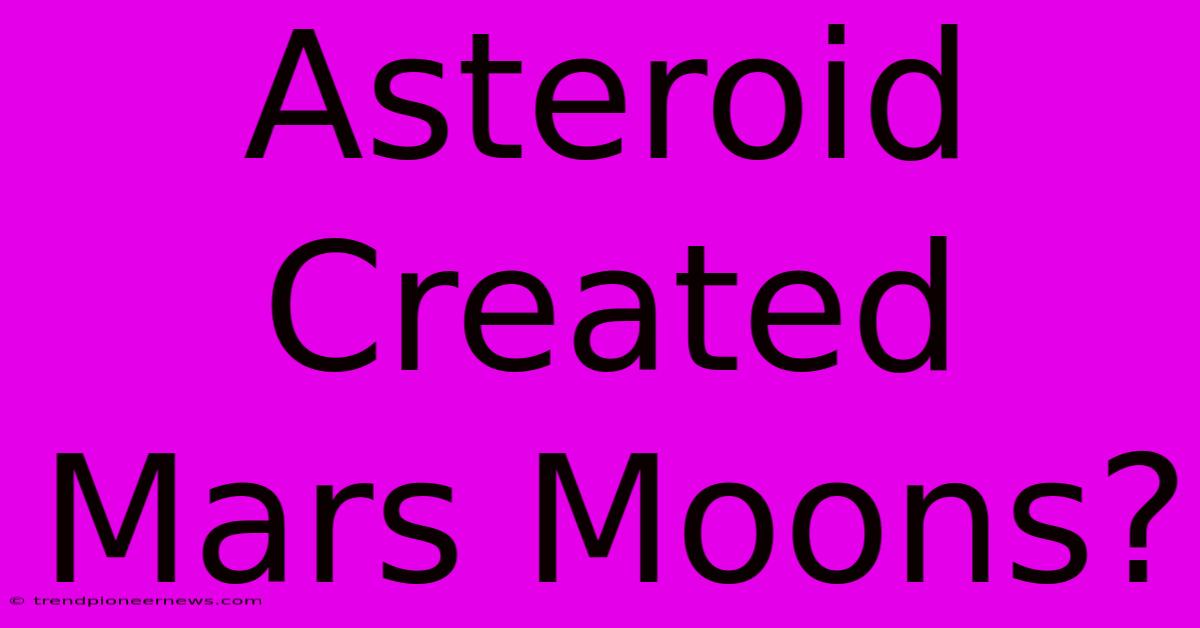Asteroid Created Mars Moons?

Discover more detailed and exciting information on our website. Click the link below to start your adventure: Visit Best Website Asteroid Created Mars Moons?. Don't miss out!
Table of Contents
Asteroid Impact: The Possible Origin of Mars' Moons
Hey everyone! So, I've always been fascinated by space, and Mars' moons, Phobos and Deimos, have always seemed… weird. I mean, they're tiny, potato-shaped, and look nothing like our beautiful, round moon. For ages, I just assumed they were captured asteroids, you know, like, "Oh yeah, Mars snagged these space rocks." But then I did some digging, and boy, did I get a rabbit hole situation going! It turns out the story might be way cooler than that.
The "Captured Asteroid" Theory: Not So Simple
The classic explanation – that Phobos and Deimos are captured asteroids – seemed straightforward enough. It's a common occurrence, right? Planets picking up stray space debris. However, there are some serious problems with this theory. Both moons have remarkably similar orbits and compositions – suspiciously similar for two randomly captured objects. It's like finding two identical twins in separate orphanages. The chances are astronomically low. That's what got me thinking something else was up.
This whole thing made me so frustrated at first! I spent hours reading papers and articles, feeling like I was drowning in technical jargon. But the more I learned, the more excited I got about the alternative explanations! It's a great example of how things aren't always what they seem.
A Giant Impact: The Mars-Sized Mystery
The leading alternative theory is a giant-impact hypothesis. Basically, a huge asteroid, maybe even massive, slammed into Mars a long, long time ago. This impact would have been catastrophic, launching a huge amount of debris into orbit. Over time, that debris would have coalesced, eventually forming Phobos and Deimos. It sounds crazy, but that's exactly what scientists believe happened when the moon formed around Earth! So not totally out of the realm of possibility.
Evidence Supporting the Giant Impact Theory
Several lines of evidence point towards this theory. The composition of Phobos and Deimos is remarkably similar to the Martian crust. This suggests they formed from Martian material ejected during the impact. Plus, their orbits are relatively stable and circular, unlike many captured asteroids that often have more chaotic, elliptical paths. It's like a super specific puzzle piece perfectly fitting into the picture.
What I Learned (and You Can Too!)
So, my initial assumptions were totally wrong. The simple "captured asteroid" explanation, while seemingly intuitive, doesn't fit the observational data. I learned to be more critical of simple explanations and to always seek out additional evidence before accepting something at face value.
Practical Tips for Aspiring Space Enthusiasts:
- Don't be afraid to question established ideas: Scientific understanding evolves constantly.
- Dig deep: Look beyond the surface-level explanations. Read scientific papers, explore different viewpoints.
- Embrace complexity: Sometimes, the simplest explanations aren't the best ones. The universe is a complex place!
This whole journey has been a total eye-opener, and it reminds me that even the most seemingly simple things can hide fascinating complexities. Who knows what other secrets the Martian moons hold? I'll keep digging and will let you know what I find! Maybe someday, we'll even visit them and unravel their mysterious origins.

Thank you for visiting our website wich cover about Asteroid Created Mars Moons?. We hope the information provided has been useful to you. Feel free to contact us if you have any questions or need further assistance. See you next time and dont miss to bookmark.
Featured Posts
-
Dangerous Driving Guilty Verdict
Nov 27, 2024
-
Ucl 2024 Bayern Vs Psg Recap
Nov 27, 2024
-
Food Supply Chain Hacked Shortages
Nov 27, 2024
-
Pakistan Beats Zimbabwe Odi
Nov 27, 2024
-
Sporting Vs Arsenal Ucl Result
Nov 27, 2024
